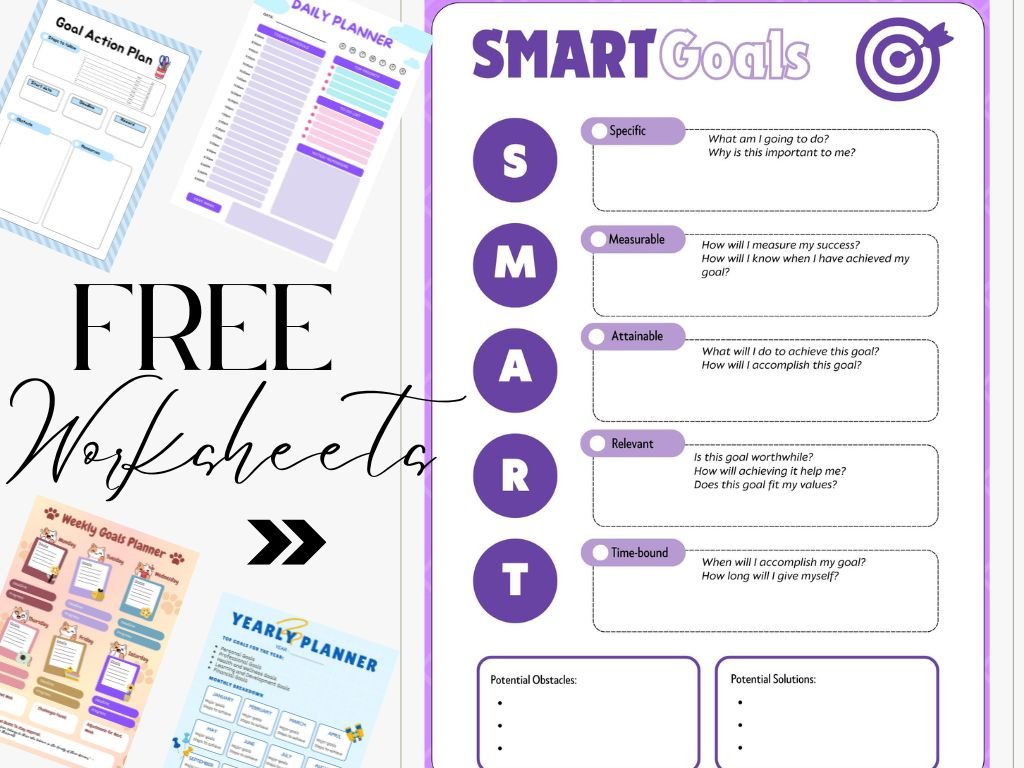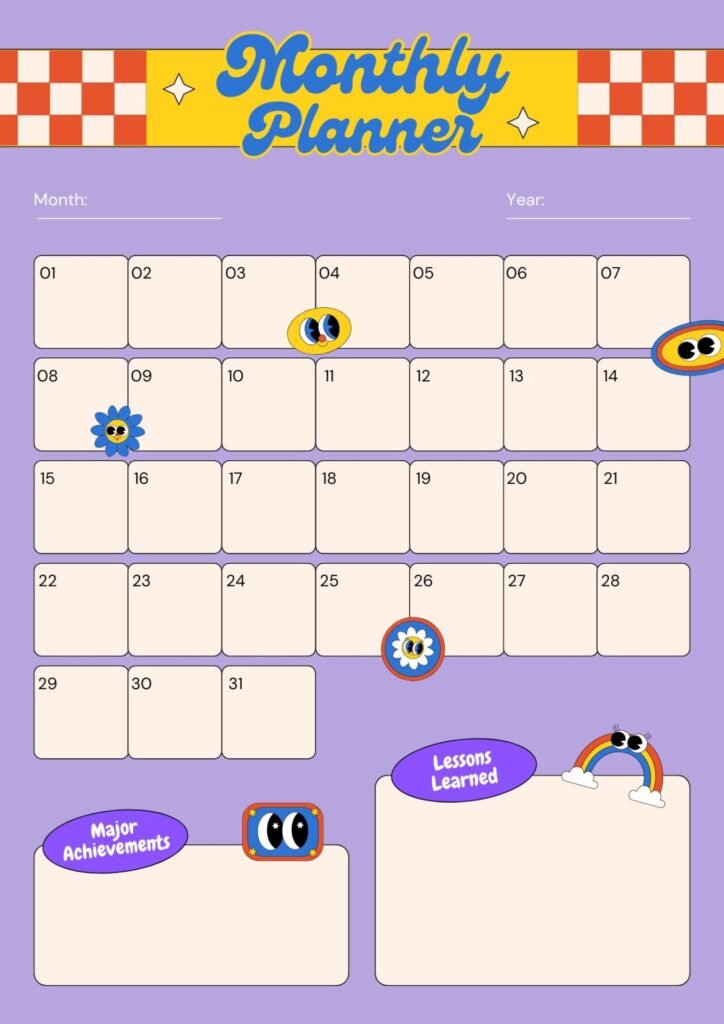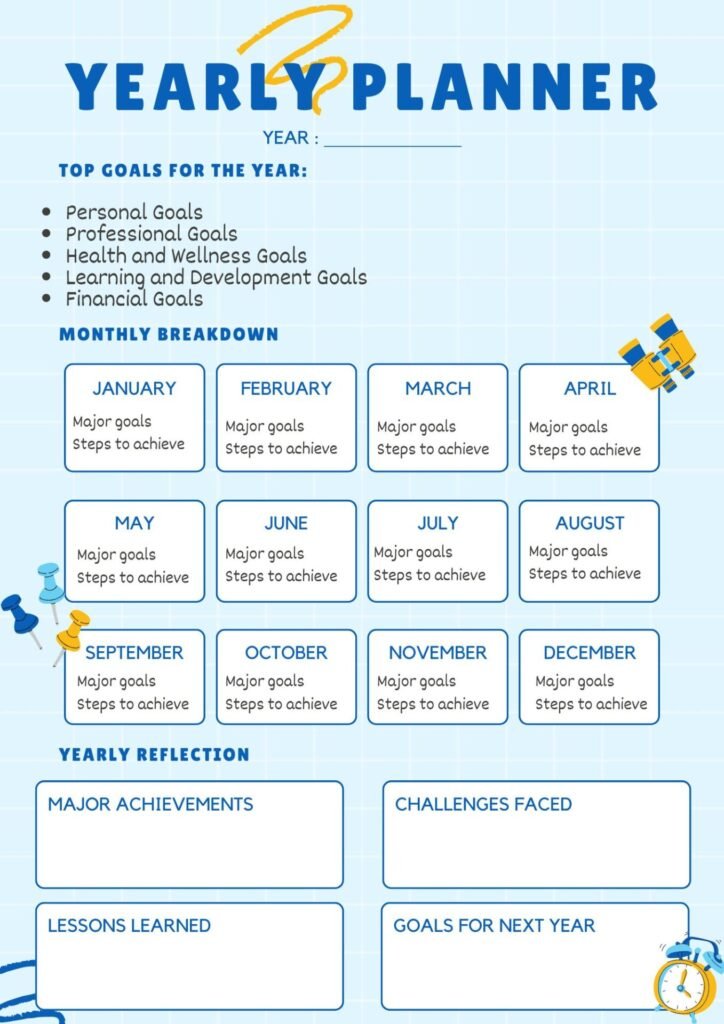Hi beautiful,
You know that feeling when you write down big goals, but they slip your mind after a few weeks? It happens to most of us.
Setting goals isn’t just about deciding what you want. You need a plan that works and the focus to stick with it.
That’s why you need goal-setting worksheets and templates. They keep you organized, break your goals into smaller steps, and make it easier to follow through.
A study by Dr. Gail Matthews at the Dominican University found that people who write down their goals are 42% more likely to achieve them. Sharing goals with a friend and providing regular updates can increase this success rate.
Goal-setting worksheets and templates
Here are some simple and easy-to-follow goal-setting worksheets and templates that will help you achieve your goals.

These goal-setting worksheets provide more than a place to write your goals. They also help you track your progress and reflect on your setbacks and achievements.
Types of Goal Setting Worksheets and Templates
There are various types of goal setting worksheets and templates available, each designed to suit different needs and preferences.
SMART Goals Template
The SMART Goals Template is one of the most popular and effective tools for goal setting. It makes your goals more realistic.

The Goals Setting Action Plan Template
The action plan template breaks down each goal into actionable steps, deadlines, and resources required.
This template ensures that you have a clear path from start to finish.

Daily Planner Worksheet
Daily planner worksheet breaks down your goals into daily tasks. This approach ensures that you make consistent progress every day.

Weekly Goal Tracker
This weekly goals-setting planner template is designed to help you organize and track your goals weekly.
It provides a balance between daily details and long-term planning. You can see your progress week by week. This template helps you prioritize tasks and set short-term milestones.

Monthly Goals Tracker
A monthly goal tracker is ideal for those who prefer a broader overview of their goals. It allows you to set and review your goals every month.

Yearly Goals Outline
A yearly goals outline helps you plan your goals for the entire year. It’s perfect for big-picture planning and long-term projects.

Benefits of Goals-Setting Worksheets and Templates
Using goal-setting worksheets and templates changes how you approach your goals. They make the process clear, more organized, and easier to follow.
Structured Approach
These tools give you a clear plan to follow. Instead of feeling scattered, you get a step-by-step way to organize your goals. They help you break down big goals into smaller, manageable tasks.
For example, if your goal is to get fit, a worksheet guides you to outline tasks like exercising three times a week or eating healthier meals.
Tracking Progress
One of the hardest parts of goal setting is staying on track. Worksheets include sections where you can record your progress.
Let’s say your goal is to read more books. You could track how many pages or chapters you read daily or weekly.
Reflecting and Adjusting
Worksheets also help you look back at what’s working and what isn’t. If something isn’t going as planned, you can tweak your approach.
Accountability
Writing down your goals and steps makes them real. It’s like making a promise to yourself. This added accountability pushes you to follow through and stay committed.
How to Choose the Right Template
Assess Your Needs
First, think about your goals. Are they short-term or long-term?
- For short-term goals, like building a habit or finishing a small project, try a daily planner worksheet. It breaks tasks into smaller steps.
- For long-term goals, like big life changes or career growth, a yearly goals worksheet is a better choice. It helps you set big milestones and track progress over time.
Match Templates to Goals
Once you know your needs, pick a template that aligns with your goal type.
- Daily planner templates are perfect for focusing on daily tasks. For example, if your goal is to exercise regularly, this template helps you schedule workouts, track them, and adjust as needed.
- Yearly goals templates help you see the bigger picture. If your goal is to save money, this template guides you to set monthly savings targets and track your progress throughout the year.
- Weekly planner templates strike a balance between short-term and long-term planning. For instance, if you want to improve your cooking skills, a weekly planner help you schedule new recipes, track ingredients, and reflect on your progress each week.
Conclusion
Goal achievement needs commitment and flexibility. You should start with these fundamentals, pick your preferred tracking method, and focus on your objectives.
The perfect moment doesn’t exist – begin your experience today with these practical tools and templates.





Hi there would you mind letting me know which web host you’re utilizing? I’ve loaded your blog in 3 completely different web browsers and I must say this blog loads a lot quicker then most. Can you recommend a good hosting provider at a fair price? Thanks, I appreciate it!
Este site é realmente incrível. Sempre que acesso eu encontro coisas diferentes Você também pode acessar o nosso site e descobrir mais detalhes! conteúdo único. Venha saber mais agora! 🙂
Awsome blog! I am loving it!! Will be back later to read some more. I am bookmarking your feeds also.
you’re in point of fact a good webmaster. The website loading pace is incredible. It seems that you are doing any unique trick. In addition, The contents are masterwork. you’ve done a wonderful job on this topic!
certainly like your web-site but you have to check the spelling on several of your posts. Several of them are rife with spelling issues and I find it very bothersome to tell the truth nevertheless I will certainly come back again.
You have remarked very interesting points! ps nice web site.
I am not certain the place you are getting your information, however good topic. I needs to spend a while finding out more or figuring out more. Thank you for wonderful information I used to be looking for this info for my mission.
Good ?V I should certainly pronounce, impressed with your site. I had no trouble navigating through all the tabs as well as related info ended up being truly easy to do to access. I recently found what I hoped for before you know it in the least. Quite unusual. Is likely to appreciate it for those who add forums or anything, website theme . a tones way for your customer to communicate. Excellent task..
I reckon something truly special in this site.
What i do not understood is actually how you’re not actually a lot more smartly-appreciated than you may be now. You’re so intelligent. You know therefore significantly on the subject of this matter, made me individually imagine it from a lot of varied angles. Its like men and women don’t seem to be involved until it is one thing to do with Lady gaga! Your own stuffs nice. All the time handle it up!
You got a very superb website, Sword lily I found it through yahoo.
A person essentially help to make seriously articles I would state. This is the first time I frequented your web page and thus far? I surprised with the research you made to make this particular publish amazing. Wonderful job!
As soon as I discovered this site I went on reddit to share some of the love with them.
You are my inspiration , I have few blogs and sometimes run out from to post : (.
Well I truly liked studying it. This post procured by you is very useful for accurate planning.
Very interesting information!Perfect just what I was looking for! “The medium is the message.” by Marshall McLuhan.
fascinate este conteúdo. Gostei muito. Aproveitem e vejam este site. informações, novidades e muito mais. Não deixem de acessar para se informar mais. Obrigado a todos e até mais. 🙂
Great post however I was wanting to know if you could write a litte more on this subject? I’d be very grateful if you could elaborate a little bit further. Appreciate it!
I’m also commenting to make you know what a amazing experience our child found reading through yuor web blog. She even learned plenty of details, most notably how it is like to possess a wonderful giving nature to have many people without hassle learn about selected impossible subject areas. You undoubtedly exceeded our own desires. I appreciate you for delivering the effective, trustworthy, revealing and also unique guidance on this topic to Kate.
Hi, I think your site might be having browser compatibility issues. When I look at your website in Safari, it looks fine but when opening in Internet Explorer, it has some overlapping. I just wanted to give you a quick heads up! Other then that, fantastic blog!